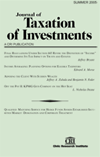What the Anti-Money Laundering Initiative Means to the Average (Non-Criminal, Non-Terrorist) Investor-Taxpayer
Author: John Ensminger.
Source: Volume 20, Number 03, Spring 2003 , pp.237-252(16)

< previous article |next article > |return to table of contents
Abstract:
The USA PATRIOT Act expanded the anti-money laundering requirements imposed on financial institutions by covering more of them and increasing the responsibilities they have for reporting and recordkeeping regarding customers, accounts, and transactions. Most of these changes will not be, and should not be, apparent to the average customer. Nevertheless, it is possible that customers with significant numbers of cash transactions, or who wire or receive funds from overseas, or who have private banking accounts with certain activity patterns, or whose names are similar to those of listed criminals or terrorists, or who belong to organizations suspected of criminal involvement by any one of a number of federal or international agencies—will find themselves up close and personal with federal investigators or enforcement agencies. One of those agencies is the Internal Revenue Service, whose Detroit Computing Center serves as the clearing house for data submitted to the Financial Crimes Enforcement Network, another Treasury agency. Though audits conducted under the Bank Secrecy Act (BSA) are not tax audits, information gathered under a BSA audit may be used by the government for tax proceedings. Thus, the anti-money laundering initiatives may result in the government knowing more than it would have strictly through tax audits. A surprising number of tax professionals are unfamiliar with the impact of the USA PATRIOT Act on their clients. Therefore, it is worth summarizing the significance of that Act for investors, businesses, and taxpayers.Keywords:
Affiliations:
.